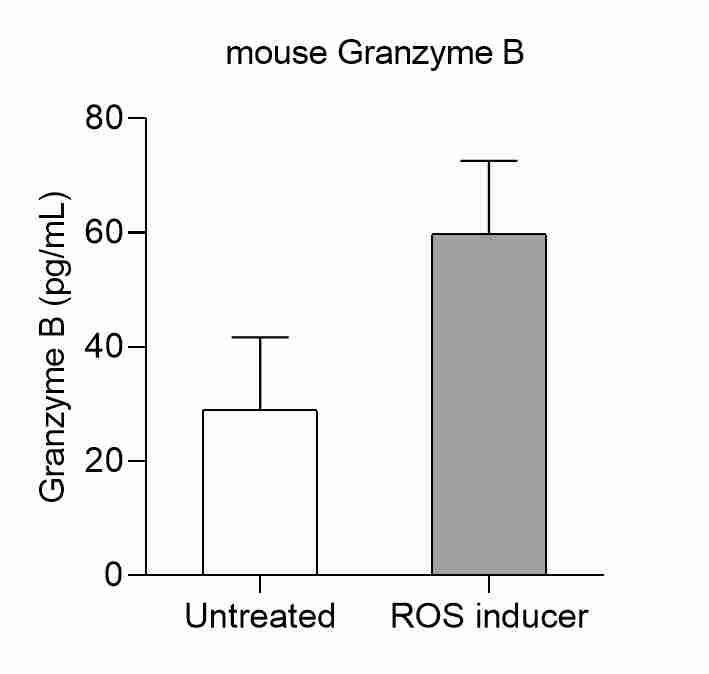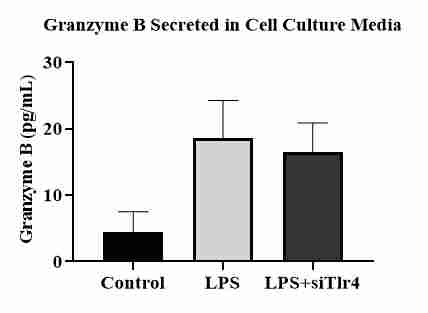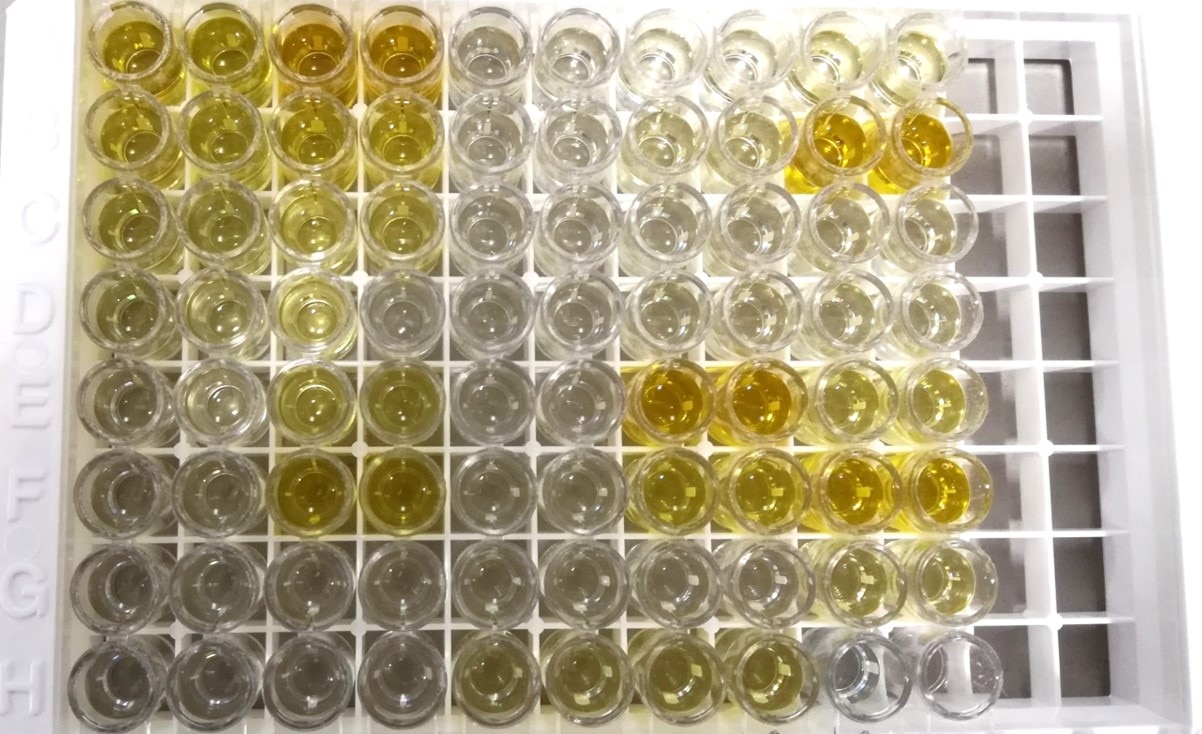Mouse Granzyme B DuoSet ELISA Summary
* Provided that the recommended microplates, buffers, diluents, substrates and solutions are used, and the assay is run as summarized in the Assay Procedure provided.
This DuoSet ELISA Development kit contains the basic components required for the development of sandwich ELISAs to measure natural and recombinant mouse Granzyme B. The suggested diluent is suitable for the analysis of most cell culture supernate, serum, and plasma samples. Diluents for complex matrices, such as serum and plasma, should be evaluated prior to use in this DuoSet.
Product Features
- Optimized capture and detection antibody pairings with recommended concentrations save lengthy development time
- Development protocols are provided to guide further assay optimization
- Assay can be customized to your specific needs
- Economical alternative to complete kits
Kit Content
- Capture Antibody
- Detection Antibody
- Recombinant Standard
- Streptavidin conjugated to horseradish-peroxidase (Streptavidin-HRP)
Other Reagents Required
DuoSet Ancillary Reagent Kit 2 (5 plates): (Catalog # DY008) containing 96 well microplates, plate sealers, substrate solution, stop solution, plate coating buffer (PBS), wash buffer, and Reagent Diluent Concentrate 2.
The components listed above may be purchased separately:
PBS: (Catalog # DY006), or 137 mM NaCl, 2.7 mM KCl, 8.1 mM Na2HPO4, 1.5 mM KH2PO4, pH 7.2 - 7.4, 0.2 µm filtered
Wash Buffer: (Catalog # WA126), or 0.05% Tween® 20 in PBS, pH 7.2-7.4
Reagent Diluent: (Catalog # DY995), or 1% BSA in PBS, pH 7.2-7.4, 0.2 µm filtered
Substrate Solution: 1:1 mixture of Color Reagent A (H2O2) and Color Reagent B (Tetramethylbenzidine) (Catalog # DY999)
Stop Solution: 2 N H2SO4 (Catalog # DY994)
Microplates: R&D Systems (Catalog # DY990)
Plate Sealers: ELISA Plate Sealers (Catalog # DY992)
Scientific Data
Product Datasheets
Preparation and Storage
Background: Granzyme B
Granzyme family serine proteases are stored in the granules of cytotoxic T lymphocytes and natural killer cells. Granzymes contain one S1 protease domain and are synthesized as preproproteins. Granzymes are released toward pathogen infected or transformed target cells during cellular immune reactions. Target cell entry by granzymes is through perforin channels. Granzymes trigger apoptosis by caspase-dependent and -independent mechanisms. There are five granzymes (A, B, G, H and K) in human and many more in mouse and rat.
Assay Procedure
GENERAL ELISA PROTOCOL
Plate Preparation
- Dilute the Capture Antibody to the working concentration in PBS without carrier protein. Immediately coat a 96-well microplate with 100 μL per well of the diluted Capture Antibody. Seal the plate and incubate overnight at room temperature.
- Aspirate each well and wash with Wash Buffer, repeating the process two times for a total of three washes. Wash by filling each well with Wash Buffer (400 μL) using a squirt bottle, manifold dispenser, or autowasher. Complete removal of liquid at each step is essential for good performance. After the last wash, remove any remaining Wash Buffer by aspirating or by inverting the plate and blotting it against clean paper towels.
- Block plates by adding 300 μL Reagent Diluent to each well. Incubate at room temperature for a minimum of 1 hour.
- Repeat the aspiration/wash as in step 2. The plates are now ready for sample addition.
Assay Procedure
- Add 100 μL of sample or standards in Reagent Diluent, or an appropriate diluent, per well. Cover with an adhesive strip and incubate 2 hours at room temperature.
- Repeat the aspiration/wash as in step 2 of Plate Preparation.
- Add 100 μL of the Detection Antibody, diluted in Reagent Diluent, to each well. Cover with a new adhesive strip and incubate 2 hours at room temperature.
- Repeat the aspiration/wash as in step 2 of Plate Preparation.
- Add 100 μL of the working dilution of Streptavidin-HRP to each well. Cover the plate and incubate for 20 minutes at room temperature. Avoid placing the plate in direct light.
- Repeat the aspiration/wash as in step 2.
- Add 100 μL of Substrate Solution to each well. Incubate for 20 minutes at room temperature. Avoid placing the plate in direct light.
- Add 50 μL of Stop Solution to each well. Gently tap the plate to ensure thorough mixing.
- Determine the optical density of each well immediately, using a microplate reader set to 450 nm. If wavelength correction is available, set to 540 nm or 570 nm. If wavelength correction is not available, subtract readings at 540 nm or 570 nm from the readings at 450 nm. This subtraction will correct for optical imperfections in the plate. Readings made directly at 450 nm without correction may be higher and less accurate.
Citations for Mouse Granzyme B DuoSet ELISA
R&D Systems personnel manually curate a database that contains references using R&D Systems products. The data collected includes not only links to publications in PubMed, but also provides information about sample types, species, and experimental conditions.
31
Citations: Showing 1 - 10
Filter your results:
Filter by:
-
Selinexor in Combination with Decitabine Attenuates Ovarian Cancer in Mice
Authors: Stiff, PJ;Mehrotra, S;Potkul, RK;Banerjee, S;Walker, C;Drakes, ML;
Cancers
Species: Mouse
Sample Types: Cell Culture Supernates
-
Streptococcus pneumoniae drives specific and lasting Natural Killer cell memory
Authors: Camarasa, TMN;Torné, J;Chevalier, C;Rasid, O;Hamon, MA;
PLoS pathogens
Species: Mouse
Sample Types: Tissue Homogenates
-
Single-cell analysis reveals the stromal dynamics and tumor-specific characteristics in the microenvironment of ovarian cancer
Authors: Zhang, L;Cascio, S;Mellors, JW;Buckanovich, RJ;Osmanbeyoglu, HU;
bioRxiv : the preprint server for biology
Species: Human
Sample Types: Cell Culture Supernates
-
NK cell-derived extracellular granzyme B drives epithelial ulceration during HSV-2 genital infection
Authors: YS Lim, AG Lee, X Jiang, JM Scott, A Cofie, S Kumar, D Kennedy, DJ Granville, H Shin
Cell Reports, 2023-04-17;42(4):112410.
Species: Mouse
Sample Types: Vaginal Lavage Fluid
-
Chemotherapy-induced tumor immunogenicity is mediated in part by megakaryocyte-erythroid progenitors
Authors: A Vorontsova, TJ Cooper, J Haj-Shomal, M Benguigui, S Levin, B Manobla, R Menachem, M Timaner, Z Raviv, Y Shaked
Oncogene, 2023-01-16;0(0):.
Species: Mouse
Sample Types: Tissue Homogenates
-
BST2, a Novel Inhibitory Receptor, Is Involved in NK Cell Cytotoxicity through Its Cytoplasmic Tail Domain
Authors: J Oh, E Yi, SK Jeong, S Park, SH Park
International Journal of Molecular Sciences, 2022-09-27;23(19):.
Species: Mouse
Sample Types: Cell Culture Supernates
-
HSP90 mediates IFNgamma-induced adaptive resistance to anti-PD-1 immunotherapy
Authors: K Liu, J Huang, J Liu, C Li, G Kroemer, D Tang, R Kang
Cancer Research, 2022-05-16;0(0):.
Species: Mouse
Sample Types: Serum
-
Peptide Adjuvant to Invigorate Cytolytic Activity of NK Cells in an Obese Mouse Cancer Model
Authors: S Han, M Jung, AS Kim, DY Lee, BH Cha, CW Putnam, KS Lim, DA Bull, YW Won
Pharmaceutics, 2021-08-17;13(8):.
Species: Mouse
Sample Types: Tissue Homogenates
-
Inhibition of host Ogr1 enhances effector CD8+ T-cell function by modulating acidic microenvironment
Authors: L Cao, W Li, X Yang, W Zhang, M Li, H Zhang, C Qin, X Chen, R Gao
Cancer Gene Therapy, 2021-06-22;0(0):.
Species: Mouse
Sample Types: Cell Culture Supernates
-
Concentrated Secretome of Adipose Stromal Cells Limits Influenza A Virus-Induced Lung Injury in Mice
Authors: NV Bogatcheva, ME Coleman
Cells, 2021-03-24;10(4):.
Species: Mouse
Sample Types: BALF
-
Encapsulation of a CpG oligonucleotide in cationic liposomes enhances its local antitumor activity following pulmonary delivery in a murine model of metastatic lung cancer
Authors: C Loira-Past, K Vanvarenbe, B Ucakar, M Machado Fr, A Staub, M Lemaire, JC Renauld, R Vanbever
International journal of pharmaceutics, 2021-03-19;600(0):120504.
Species: Mouse
Sample Types: Tissue Homogenates
-
Immunostimulatory Effects of Live Lactobacillus sakei K040706 on the CYP-Induced Immunosuppression Mouse Model
Authors: SY Kim, JS Shin, KS Chung, HS Han, HH Lee, JH Lee, SY Kim, YW Ji, Y Ha, J Kang, YK Rhee, KT Lee
Nutrients, 2020-11-22;12(11):.
Species: Mouse
Sample Types: Cell Culture Supernates
-
Synergy between hemagglutinin 2 (HA2) subunit of influenza fusogenic membrane glycoprotein and oncolytic Newcastle disease virus suppressed tumor growth and further enhanced by Immune checkpoint PD-1 blockade
Authors: SM Miri, MS Ebrahimzad, E Abdolalipo, M Yazdi, H Hosseini R, A Ghaemi
Cancer Cell Int., 2020-08-07;20(0):380.
Species: Mouse
Sample Types: Cell Culture Supernates
-
Microparticles from tumors exposed to radiation promote immune evasion in part by PD-L1
Authors: M Timaner, R Kotsofruk, Z Raviv, K Magidey, D Shechter, T Kan, A Nevelsky, S Daniel, EGE de Vries, T Zhang, O Kaidar-Per, RS Kerbel, Y Shaked
Oncogene, 2019-08-29;0(0):.
Species: Mouse
Sample Types: Cell Culture Supernates
-
Preclinical assessment of galunisertib (LY2157299 monohydrate), a first-in-class transforming growth factor-? receptor type I inhibitor
Authors: JM Yingling, WT McMillen, L Yan, H Huang, JS Sawyer, J Graff, DK Clawson, KS Britt, BD Anderson, DW Beight, D Desaiah, MM Lahn, KA Benhadji, MJ Lallena, RB Holmgaard, X Xu, F Zhang, JR Manro, PW Iversen, CV Iyer, RA Brekken, MD Kalos, KE Driscoll
Oncotarget, 2017-12-31;9(6):6659-6677.
Species: Mouse
Sample Types: Cell Culture Supernates
-
Citrullinated ?-enolase is an effective target for anti-cancer immunity
Authors: K Cook, I Daniels, P Symonds, T Pitt, M Gijon, W Xue, R Metheringh, L Durrant, V Brentville
Oncoimmunology, 2017-11-06;7(2):e1390642.
Species: Mouse
Sample Types: Cell Culture Supernates
-
Fusion to Flaviviral Leader Peptide Targets HIV-1 Reverse Transcriptase for Secretion and Reduces Its Enzymatic Activity and Ability to Induce Oxidative Stress but Has No Major Effects on Its Immunogenic Performance in DNA-Immunized Mice
Authors: A Latanova, S Petkov, Y Kuzmenko, A Kilpeläine, A Ivanov, O Smirnova, O Krotova, S Korolev, J Hinkula, V Karpov, M Isaguliant, E Starodubov
J Immunol Res, 2017-06-22;2017(0):7407136.
Species: Mouse
Sample Types: Cell Culture Supernates
-
Smac mimetics synergize with immune checkpoint inhibitors to promote tumour immunity against glioblastoma
Authors: ST Beug, CE Beauregard, C Healy, T Sanda, M St-Jean, J Chabot, DE Walker, A Mohan, N Earl, X Lun, DL Senger, SM Robbins, P Staeheli, PA Forsyth, T Alain, EC LaCasse, RG Korneluk
Nat Commun, 2017-02-15;8(0):.
Species: Mouse
Sample Types: Cell Culture Supernates
-
The Yin/Yan of CCL2: a minor role in neutrophil anti-tumor activity in vitro but a major role on the outgrowth of metastatic breast cancer lesions in the lung in vivo
Authors: N Lavender, J Yang, SC Chen, J Sai, CA Johnson, P Owens, GD Ayers, A Richmond
BMC Cancer, 2017-01-31;17(1):88.
Species: Mouse
Sample Types: Cell Culture Supernates
-
NK cells activated by Interleukin-4 in cooperation with Interleukin-15 exhibit distinctive characteristics
Proc Natl Acad Sci USA, 2016-08-22;0(0):.
Species: Mouse
Sample Types: Cell Culture Supernates
-
Cannabinoid receptor 2 modulates susceptibility to experimental cerebral malaria through a CCL17-dependent mechanism
J Biol Chem, 2016-07-29;0(0):.
Species: Mouse
Sample Types: Cell Culture Supernates
-
Citrullinated Vimentin Presented on MHC-II in Tumor Cells Is a Target for CD4+ T-Cell-Mediated Antitumor Immunity.
Authors: Brentville V, Metheringham R, Gunn B, Symonds P, Daniels I, Gijon M, Cook K, Xue W, Durrant L
Cancer Res, 2015-12-30;76(3):548-60.
Species: Mouse
Sample Types: Cell Culture Supernates
-
Lymphocytic Choriomeningitis Virus Expands a Population of NKG2D+CD8+ T Cells That Exacerbates Disease in Mice Coinfected with Leishmania major.
Authors: Crosby E, Clark M, Novais F, Wherry E, Scott P
J Immunol, 2015-08-19;195(7):3301-10.
Species: Mouse
Sample Types: Tissue Homogenates
-
Local immune response to injection of Plasmodium sporozoites into the skin.
Authors: Mac-Daniel L, Buckwalter M, Berthet M, Virk Y, Yui K, Albert M, Gueirard P, Menard R
J Immunol, 2014-06-30;193(3):1246-57.
Species: Mouse
Sample Types: Tissue Homogenates
-
Asthma increases susceptibility to heterologous but not homologous secondary influenza.
Authors: Furuya Y, Roberts S, Hurteau G, Sanfilippo A, Racine R, Metzger D
J Virol, 2014-06-04;88(16):9166-81.
Species: Mouse
Sample Types: BALF
-
Differential role of NK cells against Candida albicans infection in immunocompetent or immunocompromised mice.
Authors: Quintin J, Voigt J, van der Voort R, Jacobsen I, Verschueren I, Hube B, Giamarellos-Bourboulis E, van der Meer J, Joosten L, Kurzai O, Netea M
Eur J Immunol, 2014-05-27;44(8):2405-14.
Species: Mouse
Sample Types: Cell Culture Supernates
-
Allogeneic splenocyte transfer and lipopolysaccharide inhalations induce differential T cell expansion and lung injury: a novel model of pulmonary graft-versus-host disease.
Authors: Martinu, Tereza, Kinnier, Christin, Sun, Jesse, Kelly, Francine, Nelson, Margaret, Garantziotis, Stavros, Foster, W Michae, Palmer, Scott M
PLoS ONE, 2014-05-20;9(5):e97951.
Species: Mouse
Sample Types: BALF
-
Engagement of NKG2D on bystander memory CD8 T cells promotes increased immunopathology following Leishmania major infection.
Authors: Crosby E, Goldschmidt M, Wherry E, Scott P
PLoS Pathog, 2014-02-27;10(2):e1003970.
Species: Mouse
Sample Types: Tissue Culture Supernates
-
The E3 ligase Cbl-b and TAM receptors regulate cancer metastasis via natural killer cells.
Authors: Paolino, Magdalen, Choidas, Axel, Wallner, Stephani, Pranjic, Blanka, Uribesalgo, Iris, Loeser, Stefanie, Jamieson, Amanda M, Langdon, Wallace, Ikeda, Fumiyo, Fededa, Juan Pab, Cronin, Shane J, Nitsch, Roberto, Schultz-Fademrecht, Carsten, Eickhoff, Jan, Menninger, Sascha, Unger, Anke, Torka, Robert, Gruber, Thomas, Hinterleitner, Reinhard, Baier, Gottfrie, Wolf, Dominik, Ullrich, Axel, Klebl, Bert M, Penninger, Josef M
Nature, 2014-02-19;507(7493):508-12.
Species: Mouse
Sample Types: Cell Culture Supernates
-
Regulatory T cells expressing granzyme B play a critical role in controlling lung inflammation during acute viral infection.
Authors: Loebbermann J, Thornton H, Durant L
Mucosal Immunol, 2012-01-11;5(2):161-72.
Species: Mouse
Sample Types: BALF
-
Plac8-dependent and inducible NO synthase-dependent mechanisms clear Chlamydia muridarum infections from the genital tract.
Authors: Johnson RM, Kerr MS, Slaven JE
J. Immunol., 2012-01-11;188(4):1896-904.
Species: Mouse
Sample Types: Cell Culture Supernates
FAQs
No product specific FAQs exist for this product, however you may
View all ELISA FAQsReviews for Mouse Granzyme B DuoSet ELISA
Average Rating: 4.8 (Based on 4 Reviews)
Have you used Mouse Granzyme B DuoSet ELISA?
Submit a review and receive an Amazon gift card.
$25/€18/£15/$25CAN/¥75 Yuan/¥2500 Yen for a review with an image
$10/€7/£6/$10 CAD/¥70 Yuan/¥1110 Yen for a review without an image
Filter by:
Bone Marrow Derived Macrophages







